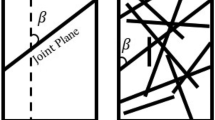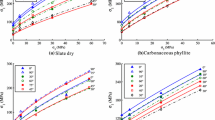Abstract
The Hoek–Brown (HB) failure criterion is one of the most widely used failure criteria in rock engineering. Based on the Geological Strength Index (GSI) system, a number of empirical models have been proposed in parallel with this criterion to estimate the strength and deformation properties of rock masses such as uniaxial compressive strength (UCS) and deformation modulus. However, the GSI system does not incorporate the effects of joint orientation β on the quality of a rock mass. This means that these empirical models cannot capture anisotropic rock mass strength caused by joint orientations. In this research, UDEC rock mass models, which are calibrated by laboratory data, are used to investigate the effects of joint orientation on rock mass strength in an unconfined state. The values of UCS obtained from the numerical simulation are then compared with those calculated from traditional empirical UCS models based on the GSI system. The comparison study shows that the value of UCS is significantly overestimated by the traditional empirical model when 10° < β < 45°, which will have serious safety implications for engineering designs. To rectify the problem, based on the analysis of numerical simulation results, an anisotropic weighting factor fβ is proposed to be used to refine the empirical UCS model. The modified UCS model is demonstrated to be capable of giving conservative but more accurate prediction of the rock mass strength for various joint orientations, which will result in more optimal and safer engineering designs.


















Similar content being viewed by others
Abbreviations
- A, B, C :
-
Fitting parameters
- D :
-
Disturbance factor
- E :
-
Young’s modulus of intact rock
- f β :
-
Joint orientation weighting factor
- m i :
-
Hoek–Brown constant
- m b, s, a :
-
HB input parameter of rock mass
- σ 1 :
-
The maximum principal stress
- σ 3 :
-
The minimum principal stress
- υ :
-
Poisson’s ratio of intact rock
- c :
-
Cohesion of intact rock
- ϕ :
-
Friction angle of intact rock
- γ :
-
Unit weight of intact rock
- β :
-
Joint orientation
- k n :
-
Joint normal stiffness
- k s :
-
Joint shear stiffness
- σ tj :
-
Joint tensile strength
- c j :
-
Joint cohesion
- ϕ j :
-
Joint friction
- σ ci :
-
UCS of intact rock
- σ cm :
-
UCS of rock mass
- σ cm−Lab :
-
UCS of rock mass from laboratory test
- σ cm−E :
-
UCS of rock mass from empirical equation
- σ cm_N :
-
UCS of rock mass from numerical simulation
- σ cm_N( β) :
-
UCS of rock mass with joint orientation β
- σ cm_N(10°) :
-
UCS of rock mass with joint orientation β = 10°
References
Alejano LR, Arzúa J, Bozorgzadeh N, Harrison JP (2017) Triaxial strength and deformability of intact and increasingly jointed granite samples. Int J Rock Mech Min Sci 95:87–103
Alshkane YM, Marshall AM, Stace LR (2017) Prediction of strength and deformability of an interlocked blocky rock mass using UDEC. J Rock Mech Geotech Eng 9(3):149–160
Arzúa J, Alejano LR, Walton G (2014) Strength and dilation of jointed granite specimens in servo-controlled triaxial tests. Int J Rock Mech Min Sci 69(3):93–104
Bieniawski ZT (1973) Engineering classification of jointed rock masses. Trans. S. African Inst. Civ Eng 15(12):335–343
Brown ET, Trollope DH (1970) Strength of a model of jointed rock. J Soil Mech Found Div 96:685–704
Cai M, Kaiser PK, Uno H, Tasaka Y, Minami M (2004) Estimation of rock mass deformation modulus and strength of jointed hard rock masses using the GSI system. Int J Rock Mech Min Sci 41(1):3–19
Cao R, Cao P, Fan X, Xiong X, Lin H (2016) An experimental and numerical study on mechanical behavior of ubiquitous-joint brittle rock-like specimens under uniaxial compression. Rock Mech Rock Eng 49(11):1–20
Darlington WJ, Ranjith PG, Choi SK (2011) The effect of specimen size on strength and other properties in laboratory testing of rock and rock-like cementitious brittle materials. Rock Mech Rock Eng 44(5):513–529
Dershowitz WS, Einstein HH (1988) Characterizing rock joint geometry with joint system models. Rock Mech Rock Eng 21(1):21–51
Fan L, Yi X, Ma G (2013) Numerical manifold method (NMM) simulation of stress wave propagation through fractured rock mass[J]. Int J Appl Mech 5(2):1350022
Ghazvinian A, Hadei MR (2012) Effect of discontinuity orientation and confinement on the strength of jointed anisotropic rocks. Int J Rock Mech Min Sci 55(10):117–124
He S, Li Y, Aydin A (2018) A comparative study of UDEC simulations of an unsupported rock tunnel. Tunn Undergr Space Technol 72:242–249
Hoek E, Brown ET (1980) Underground excavations in rock. Instn Min. Metall, London
Hoek E, Brown ET (2018) The Hoek-Brown failure criterion and GSI – 2018 edition. J Rock Mech Geotech Eng. https://doi.org/10.1016/j.jrmge.2018.08.001
Hoek E, Carranza-Torres C, Corkum B (2002) Hoek-Brown failure criterion. In: Bawden, H.R.W., Curran, J., Telesnicki, M. (Eds.), Proc. North American Rock Mechanics Society (NARMS-TAC 2002), 2002 edition. Mining Innovation and Technology, Toronto, Canada, pp. 267–273
Hoek E, Carter T, Diederichs M (2013) Quantification of the Geological Strength Index chart. 47th US Rock Mechanics/Geomechanics Symposium, San Francisco: ARMA13-672
Itasca (2011) UDEC (universal distinct element code). Version 5.0. Minneapolis
Itasca (2016) 3DEC (three-dimensional distinct element code). Version 5.20. Minneapolis
Jimenez R, Serrano A, Olalla C (2008) Linearization of the Hoek and Brown rock failure criterion for tunnelling in elasto-plastic rock masses. Int J Rock Mech Min Sci 45(7):1153–1163
Kim B, Cai M, Kaiser PK, Yang H (2007) Estimation of block sizes for rock masses with non-persistent joints. Rock Mech Rock Eng 40(2):169–192
Kulatilake PHSW, Liang J, Gao H (2001) Experimental and numerical simulations of jointed rock block strength under uniaxial loading. J Eng Mech-ASCE 127(12):1240–1247
Kulatilake PHSW, He W, Um J, Wang H (2015) A physical model study of jointed rock mass strength under uniaxial compressive loading. Int J Rock Mech Min Sci 34(3–4):165.e1–165.e15
Meng J, Cao P, Huang J, Lin H, Chen Y, Cao R (2019) Second-order cone pro- gramming formulation of discontinuous deformation analysis. Int J Numer Methods Eng. https://doi.org/10.1002/nme.6006
Shen J, Karakus M (2014) Three-dimensional numerical analysis for rock slope stability using shear strength reduction method. Can Geotech J 51(2):164–172
Shen J, Priest S, Karakus M (2012) Determination of Mohr-Coulomb shear strength parameters from Generalized Hoek-Brown criterion for slope stability analysis. Rock Mech Rock Eng 45:123–129
Shen J, Karakus M, Xu C (2013) Chart-based slope stability assessment using the generalized Hoek-Brown criterion. Int J Rock Mech Min Sci 64:210–219
Singh M, Rao KS, Ramamurthy T (2002) Strength and deformational behaviour of a jointed rock mass. Rock Mech Rock Eng 35(1):45–64
Vásárhelyi B, Kovács L, Ákos T (2016) Analysing the modified Hoek–Brown failure criteria using Hungarian granitic rocks. Geomechanics and Geophysics for Geo-Energy. Geo-Resources 2(2):131–136
Vergara MR, Jan MVS, Lorig L (2016) Numerical model for the study of the strength and failure modes of rock containing non-persistent joints. Rock Mech Rock Eng 49(4):1211–1226
Vorobiev OY, Rubin MB (2018) A thermomechanical anisotropic continuum model for geological materials with multiple joint sets. Int J Numer Anal Methods Geomech 42:1366–1388
Wang W, Shen J (2017) Comparison of existing methods and a new tensile strength based model in estimating the Hoek-Brown constant mi for intact rocks. Eng Geol 224:87–96
Wang Y, Jing H, Su H, Xie J (2017) Effect of a fault fracture zone on the stability of tunnel-surrounding rock. Int J Geomech 17(6):1–20
Wang Y, Guo P, Dai F, Li X, Zhao Y, Liu Y (2018) Behavior and modeling of fiber-reinforced clay under triaxial compression by combining the superposition method with the energy-based homogenization technique. Int J Geomech 18(12):04018172
Wu Z, Fan L (2014) The numerical manifold method for elastic wave propagation in rock with time-dependent absorbing boundary conditions. Eng Anal Bound Elem 46:41–50
Wu Z, Fan L, Liu Q, Ma G (2017) Micro-mechanical modeling of the macro-mechanical response and fracture behavior of rock using the numerical manifold method. Eng Geol 225:49–60
Yang Z, Chen J, Huang T (1998) Effect of joint sets on the strength and deformation of rock mass models. Int J Rock Mech Min Sci 35(1):75–84
Zhang Y, Wong L (2018) A review of numerical techniques approaching microstructures of crystalline rocks. Comp Geotech 115:167–187
Zhang Y, Ren F, Yang T, Wang S, Zhang W, Yu M (2018) An improved rock mass characterization method using a quantified geological strength index and synthetic rock mass model. Rock Mech Rock Eng 51(11):3521–3536
Zheng H, Li T, Shen J, Xu C, Sun H, Lü Q (2018a) The effects of blast damage zone thickness on rock slope stability. Eng Geol 246:19–27
Zheng Y, Chen C, Liu T, Zhang H, Xia K, Liu F (2018b) Study on the mechanisms of flexural toppling failure in anti-inclined rock slopes using numerical and limit equilibrium models. Eng Geol 237:116–128
Zuo J, Liu H, Li H (2015) A theoretical derivation of the Hoek–Brown failure criterion for rock materials. J Rock Mech Geotech Eng 7(4):361–366
Acknowledgements
This research was funded by the National Natural Science Foundation of China (No. 51504218) and the State Key Laboratory for GeoMechanics and Deep Underground Engineering, China University of Mining and Technology (SKLGDUEK1808).
Author information
Authors and Affiliations
Corresponding author
Additional information
Publisher’s Note
Springer Nature remains neutral with regard to jurisdictional claims in published maps and institutional affiliations.
Rights and permissions
About this article
Cite this article
Huang, F., Shen, J., Cai, M. et al. An Empirical UCS Model for Anisotropic Blocky Rock Masses. Rock Mech Rock Eng 52, 3119–3131 (2019). https://doi.org/10.1007/s00603-019-01771-2
Received:
Accepted:
Published:
Issue Date:
DOI: https://doi.org/10.1007/s00603-019-01771-2




